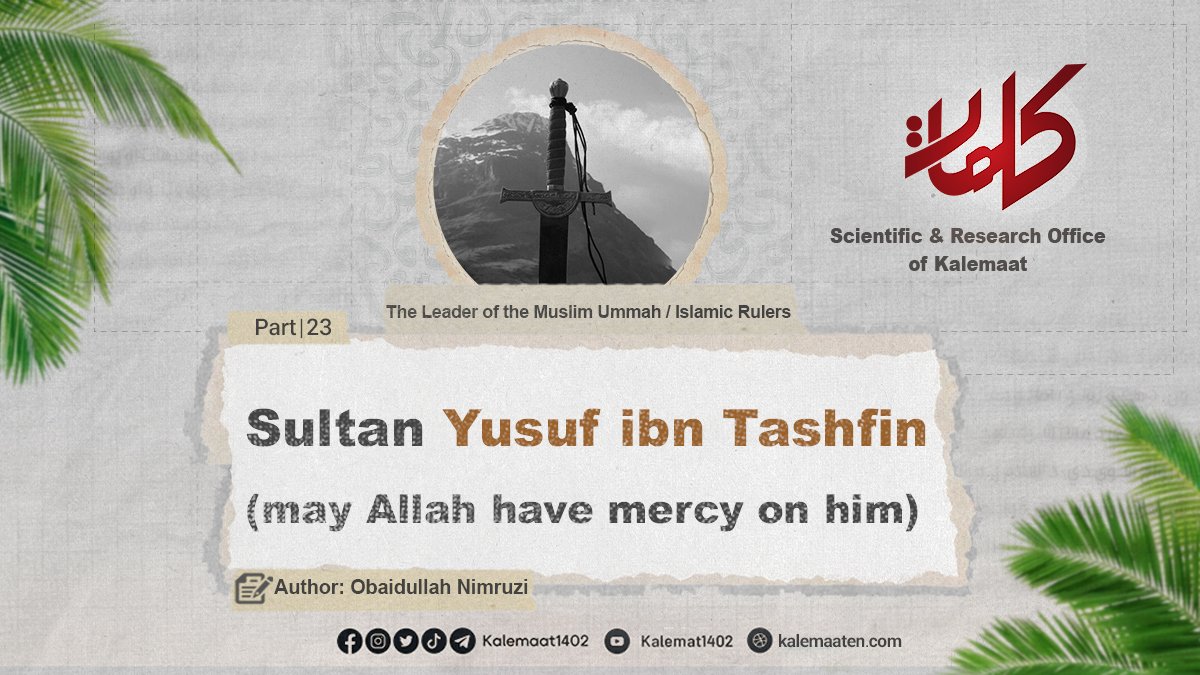Author: Obaidullah Nimruzi
The Guardian of Al-Andalus (Spain): Sultan Yusuf ibn Tashfin [MABH] (Part 23)
An Overview of the Murabitun (Almoravid) Army and the Appointment of Commanders
In the valley of Malwiya, the army of the Murabitun — those who had dedicated their lives to striving in the path of Allah — was reviewed. Their number reached forty thousand men. [1] Among them, four commanders were chosen, each assigned leadership over five thousand warriors from his own tribe, to serve as the vanguard of the Murabitun army. These four commanders were: Muhammad ibn Tamim al-Jadali, Imran ibn Sulayman al-Masufi, Madrek al-Talkani, Syr ibn Abi Bakr.
Among the commanders of the Murabitun, some were regarded as the most prominent and renowned military figures. These include:
-
Commander Syr ibn Abi Bakr al-Lamtuni [2]
Syr ibn Abi Bakr was one of the most distinguished leaders of the Lamtuna tribe and related to the Amir al-Muslimin (Commander of the Muslims) through marriage. His military brilliance and combat skill were revealed in the Battle of Zallaqah in 479 AH. During the third crossing of the Amir al-Muslimin into Al-Andalus, he entrusted the affairs of the region to Sir and tasked him with subduing the petty kings (muluk al-tawaif) in western Al-Andalus, relying on his proven competence and sincerity.
In 484 AH, he captured the city of Seville from the Banu ‘Abbad dynasty, then took control of the kingdom of Badajoz from the Banu Aftas. Afterward, he seized the western fortresses from the city of Yabura to Lisbon. He secured the borders from Christian attacks, and in 498 AH, when Alfonso VI attacked Seville, Sir defeated him.
It was Syr ibn Abi Bakr who led the counterattack at the Battle of Zallaqah, rescuing Ibn ‘Abbad and halting the Christian advance against the Muslims of Al-Andalus. [3] He passed away in 507 AH. May Allah have mercy on him.
-
Commander Muzdali ibn Muhammad [4]
Muzdali ibn Muhammad ibn Yulaktan (or Tilkan ibn al-Hasan ibn Muhammad) was a cousin of Amir Yusuf ibn Tashfin. He was one of the pillars of the state and a prominent leader among the Lamtuna tribe. Muzdali was a brave, seasoned, and diligent man, with sharp judgment and extensive military experience, and he lived a long life. His victories inflicted severe blows on the enemy.
One of his most notable achievements was recapturing the city of Valencia from the forces of “El Cid” in 495 AH / 1102 CE. [El Cid, real name Rodrigo Díaz, was a Castilian adventurer nicknamed “El Campeador” (“The Battler”). He was an immoral, ruthless, and anti-virtue mercenary — a professional robber and criminal who even burned some of the people of Valencia alive.]
Following this victory, Muzdali became the ruler of Valencia and took part in many battles against the Christians, including an assault on Barcelona in the same year, 495 AH. He was ultimately martyred near Toledo in 508 AH. May Allah have mercy on him.
-
Commander Muhammad ibn Ayesha [5]
Abu ‘Abdullah Muhammad ibn Yusuf ibn Tashfin, son of the Amir al-Muslimin, was named after his mother, in accordance with the Murabitun custom of attributing some children to their mothers rather than to their fathers.
He was one of the renowned horsemen of the Murabitun and a high-ranking commander. After the devastation caused by El Cid in eastern Al-Andalus, the Amir al-Muslimin appointed him to command that region and govern the city of Murcia to restore order.
He fought valiantly in the famous Battle of Uqlish during the reign of Ali ibn Yusuf. He was so courageous in the battle that he suffered severe eye injuries, eventually becoming blind. Afterwards, his brother, Ibrahim ibn Yusuf ibn Tashfin, succeeded him as governor of Murcia.
-
Commander Abu Abdullah Muhammad ibn Alhajj [6]
He was one of the famous elders of the Lamtuna tribe and a relative of Amir al-Muslimin Yusuf ibn Tashfin. Because of his father’s pilgrimage, he was known as “Ibn Alhajj” (son of the pilgrim). His military capabilities blossomed in Al-Andalus; in 484 AH, he conquered the city of Cordoba and fought against the Castilians.
During the reign of Ali ibn Yusuf, he was appointed governor of the Maghrib and later tasked with heading to Valencia. When the ruler of Zaragoza, ‘Abd al-Malik ibn al-Musta’in, allied with the Christians and endangered the city, the people sought aid from Amir Ali ibn Yusuf.
In response, Muhammad ibn al-Hajj went to the region and, in 503 AH, captured Zaragoza. He governed it for an extended period, safeguarding it from the Christian forces who surrounded it from the east, west, and north.
Continues…
Previous Part / Next Part
References:
[1] Ibn al-Khatib, A’mal al-A’lam, vol. 3, p. 234
[2] Ibn al-Kardabus, Nass Tarikh al-Andalus, p. 106
[3] Ibn Abi Zar’, Rawd al-Qirtas, p. 95
[4] Anan, ‘Asr al-Murabitin, p. 72
[5] al-Nuwayri, Nihayat al-Arab, vol. 24, p. 265; Ibn al-Kardabus, Nass Tarikh al-Andalus, p. 101
[6] Anan, Muhammad ‘Abdullah, ‘Asr al-Murabitin fi al-Maghrib wa al-Andalus, 2nd ed., Cairo: Maktabat al-Khanji, 1991, p. 74



